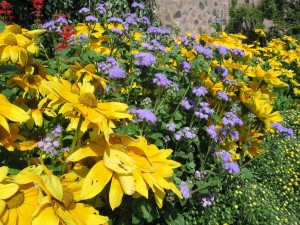Going green is an important trend spreading across Arizona, the nation and the world. But how can you make gardening more green? Easy. Here are three areas to help your garden — and the environment — thrive.
Natural pesticides:
Pesticides are a controversial treatment because of their potential effect on the environment and your health. Jim LaBrie, owner of Bug & Weed Mart for the last 35 years, suggests some easy alternatives to help reduce pests before even using a pesticide.
- Keep your house surroundings clear – this means keep clear all excess leaves, clutter and debris; keep landscaping and trees trimmed so they do not overlap your roof and invite in pests such as rodents, spiders and scorpions; and keep woodpiles away from your building.
- Get rid of standing water after it rains and make sure that rainwater, drip systems, and air-conditioning lines drain away from your building to keep mosquitoes, scorpions and termites away.
- Caulk or seal any open areas such as pipes, door frames, bases of housing that meet stem walls and pet doors.
If these natural solutions do not help with pests, LaBrie also suggests an organic pesticide if you are worried about chemicals. Bug & Weed Mart carries a new organic pesticide that is extracted from chrysanthemum flowers from Kenya. LaBrie explains, “Most natural products don’t do very much and some only last a few hours for a quick impact. For the pyrethrums, they have found a way to string it out so that it can be effective for about 28 days.” The pyrethrums are one of the most effective organic pesticides because they can last longer than the others; however, LaBrie also suggests some alternatives such as Mop Up (a natural boric acid insecticide), Bt or Bacillus thuringiensis (a natural bacterium usually used for mosquitoes), and traps such as bee traps that send out pheromones and capture bees.
Composting:
Composting is another popular aspect of environmentally friendly gardening. Composting occurs naturally, but backyard composting is the intentional and managed decomposition of organic material. The Garden of Oz describes every aspect of composting and its benefits. For home gardeners the main benefit is improved soil and therefore healthier and more productive plants. Environmental benefits include the reduction of solid waste in landfills and the reduced use of fertilizers and chemicals. Composts are made up of layers of green and brown materials.
Some green materials include:
- fresh grass clippings
- fresh manure (not from household pets)
- kitchen scraps such as fruits, vegetables, coffee grounds, or tea bags
- weeds (that have not been chemically treated with pesticides or herbicides)
Some brown materials include:
- dry leaves and grass
- twigs
- shredded papers
- straw
- small amounts of sawdust
To start your compost, Jeff Yeager from The Daily Green suggests building a square or round bin (roughly equal in height, width and depth around three or four feet) with wire fencing or pressure treated lumber. Next, layer your brown and green materials (about four parts brown to one part green) and water each layer as you go. After a week or two, mix the layers using a pitchfork or other tool, cover it with a tarp (to keep it warm and moist), and let it heat up which quickens the composting process. Composting can take several months to be ready, so be patient!
Reduce your water usage:
This green gardening tip may be the most useful to Arizonans with limited water resources. Many people over water their lawns and gardens, but here are some tips to help save water.
- Water in the morning when evaporation is less likely
- Water more deeply and less often (water straight into the roots)
- Use soaker or drip irrigation (these can use 50% less water than sprinklers)
- Garden with native plants so that they do not require much more than rain water
- Mulch your garden to lock in moisture
- Harvest rainwater (You can add a rain barrel to your house which will provide chemical free water for lawns and gardens as well as for washing cars and windows). Be sure to place a screen on top of your barrel to keep out insects, debris, and bird droppings and also use your water frequently to help keep it moving and aerated!



